When we talk about vision problems then refractive errors come on top of the list. There are millions of people, of all ages and without gender discrimination are affected by it globally.
The main cause of refractive errors is shape of eye that prevents the light from focusing on the retina. As a result blurred image is formed.
It is not possible that you simply ignore these errors. They need special assistance for making quality of life better. There are number of treatments options available to correct these refractive errors and make vision clear.
Types of Refractive Errors
When light does not fall on retina properly then it results in refractive errors. In refractive errors vision is not clear but it is blurred or distorted due to improper bending of light by eye.
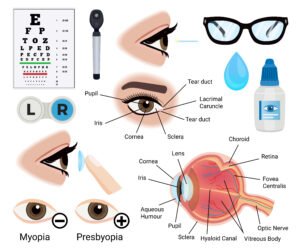
There are four types of refractive errors.
- Myopia
- Hyperopia
- Astigmatism
- Presbyopia
Each error affects sights differently.
Myopia (Nearsightedness)
It is type of refractive error in which person cannot see distant objects clearly. They appear blurry. But he can see close objects clearly without any distortion. This is most common refractive error among children and young adults.
There are two main causes of myopia.
- The eyeball is too long.
- The cornea is too curved.
Due to these changes light rays focus in front of retina. They have to focus on retina for clear image. When they focus before retina image gets blurred.
Hyperopia (Farsightedness)
It is opposite of myopia which means that person having hyperopia can see distant objects clearly but close objects appears blurry. In severe cases both far and close objects may appear blurry.
There are two main causes of hyperopia.
- The eyeball is too short
- The cornea has short curvature.
Due to these two causes light focuses behind the retina instead of on retina.
Astigmatism
When shape of cornea or lens is irregular it results in astigmatism. During this refractive disorder light focuses on multiple points instead of one point.
The main causes of astigmatism are as follows.
- Irregular curvature of cornea
- Irregular shape of lens
Types of Astigmatism
On basis of shape of cornea and lens astigmatism is further classified into following types.
- Corneal Astigmatism: Irregular shape of the cornea.
- Lenticular Astigmatism: Irregular shape of the lens inside the eye.
- With-the-rule Astigmatism: Vertical meridian is steeper.
- Against-the-rule Astigmatism: Horizontal meridian is steeper.
- Oblique Astigmatism: The steepest curvature is not aligned vertically or horizontally
- With-the-rule Astigmatism: Vertical meridian is steeper.
Presbyopia
Presbyopia is related to age and typically begins at the age of 40. Unlike other refractive errors, it is not caused by the shape of cornea or lens but it is caused due to the hardening of the lens. When lens gets harder with age, it makes difficult for the eye to focus on near objects. As a result a person can’t see closer objects clearly but distant objects appear clearly.

Main causes of presbyopia are as follows.
- Natural aging process.
- Loss of elasticity in the eye’s lens.
- Weakening of the ciliary muscles responsible for lens adjustment.
Mixed Refractive Errors
It is also possible that a person has more than one refractive error. For example
- Myopic astigmatism (myopia + astigmatism).
- Hyperopic astigmatism (hyperopia + astigmatism).
- As people age, they may develop presbyopia on top of existing myopia or hyperopia.
Causes of Refractive Errors
It is essential to understand the causes of refractive errors so that an effective diagnosis and treatment should be provided. There are several factors which are responsible for the refractive errors.
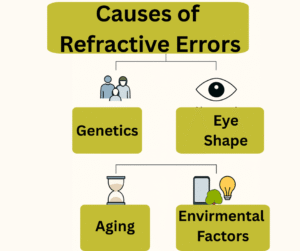
Genetic Factors
When looking for the causes of refractive errors family history is very crucial. If one or both parent have refractive error then there is higher chance of having refractive errors among the children.
Abnormal Eye Shape
The most direct cause of refractive problem is shape of eye ball, cornea or lens. When these parts of eyes have irregular shape, it results in the blurred vision.
- Myopia is caused by the longer eyeball.
- Hyperopia is caused due to shorted eyeball.
- Astigmatism is caused due to uneven curvature of cornea.
Aging
Another very important factor which causes error in vision is aging. Presbyopia is natural process that starts by the age of 40. During the aging process lens inside the eye becomes hard and less flexible which makes it difficult to focus of close objects.
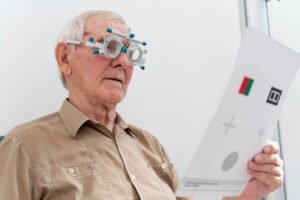
Environmental Factors
Vision is greatly affected by the environmental factors as well. Following factors have key roles in developing refractive errors.
- Spending time with screens
- Using screens in dark rooms
- Reading or writing in poor light
- Reading or using screen while on ride.
- Lack of outdoor activities in childhood
Effects of Refractive Errors
It is advised to treat your refractive errors timely to reduce its risk and effects on life in long terms as sight is precious. Once it is lost it becomes almost impossible to reverse it.
Here are some effects of refractive errors on daily life if left untreated.
Blurred Vision

When you can’t see objects clearly, it makes difficult for you to complete your daily tasks like reading, cooking, driving or using digital devices. Blurred vision is in itself a metal disturbance which makes you uneasy in daily life.
Eye Strain and Fatigue

When you find it difficult to see object clearly you try to focus, which makes your eyes and msucles tired. When you perform a visual task with refractive errors it causes excessive squinting and headaches. Your eyes also become red and tired.
Reduced Quality of Life
Eyes are the windows to the world when they can’t see around clearly it automatically start to effect your mental health and quality of life.
Uncorrected refractive errors in a person make him to struggle with academic performance, work productivity and mental health due to vision limitation.
Risk of Accidents
Most of the time people with refractive errors think that they can drive without treatment or use of glasses and lens. This is very risky practice. It increases the risk of accidents and dangerous for you and others as well.
Diagnosis of Refractive Errors
It is simple and non-invasive for diagnosing refractive errors. Eye exam is carried out by a certified eye care professional optometrist or ophthalmologist to determine the type and extent of refractive issue.
Main test carried out during eye exams are as follows:
- Visual acuity test
- Retinoscopy
- Refraction test
- Keratometry
These tests are performed by eye care professionals according to the signs and symptoms described by the patient. These tests help them to prescribe lens to correct these errors. They may recommend other treatments according individual’s needs
Treatments for Refractive Errors
There are many ways to correct the errors of refraction. Mostly in depends on the preferences of patients and severity of error that what treatment is more effective to reduce these errors.
Glasses
Most simple and popular method for the correction of vision is eyeglasses. These glasses have mirrors which helps the eye to focus the light rays on retina so a clear image is formed. When light focuses on retina properly it aids the vision to be clearer.

People with error in distant vision are advised to wear glasses for whole day. They have negative number.
People who have error to see closer objects need to wear glasses only when they are doing anything that requires focus.
Contact Lenses
If you don’t want to wear glasses and want to have more natural look then you can opt for contact lenses. They work similar as of glasses but give you natural field of view.
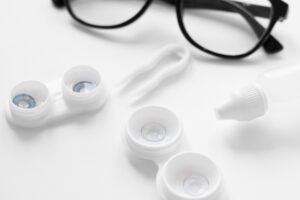
Contact lenses have different types like soft, rigid gas-permeable, toric and multifocal. According to patients need and preference contact lenses are prescribed by the eye care professionals.
Refractive Surgery
Nowadays with the help of laser technology procedures are performed to reshape the cornea. After laser mostly there is no need to wear glasses or contact lenses.

There are different procedure like LASIK, PRK and SMILE that uses laser technology for the correction of refractive errors. These surgeries are generally safe and effective for adults.
Orthokeratology (Ortho-K)
This is non-surgical treatment for the errors of refraction. In theis treatment there are specially designed contact lenses for overnight that reshapes the cornea. It is mostly used in the children to manage myopia.
Vision Therapy
There are some cases in which eye exercises and vision training are effective to improve focusing issues. It is mostly recommended to children with mild refractive errors or binocular problems.
Preventing and Managing Refractive Errors
When error is caused due genetics or age then it is unavoidable but you can take proactive meaures to protect your vision.
Regular Eye Exams
If error is detected early then it allows you for timely treatment to reduce the complications and vision.

It is recommended that if you are using glasses or lenses then go for regular checkup to know if your number has changed. If you will continue to use old prescribed glasses then it also affects your vision more vigorously.
Limit Screen Time
The part which is most effected by the screens is eye. So to protect your eye and vision you must keep on blinking while watching screens. After every 20 minutes look away to something for 20 seconds to relax your eyes.
Make your habit to not us screen before bed time and manage your screen time for the safety of your vision.
You can use eye exercise to boost your vision especially while using screens
Use Proper Lighting
Whenever you are doing a visual task make whether it is reading, writing or any other activity that requires vision, make it sure that there is proper light available.

When you do visual activities in dim light it affects you vision and cause vision errors.
Living with Refractive Errors
Now it is not difficult to live with refractive errors because technology has provided the solution to theses refractive errors. Whether you are optioning glasses, lenses or surgical procedure, they have successfully managed the everyday problem of vision successfully.
It is best for you to consult a qualified eye care provider to determine which treatment is best for you according to your age, need and preferences.
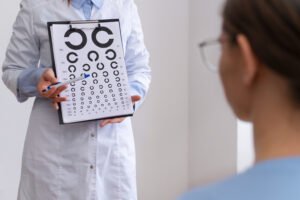
Refractive errors are very common but treatable. When you understand cause, effect and treatment of your error then you can take better option for clear vision and make your life comfortable.
If you have headaches, blurry vision, or eye strain then don’t ignore these signs. You must consult a professional for detail evaluation of your vision.

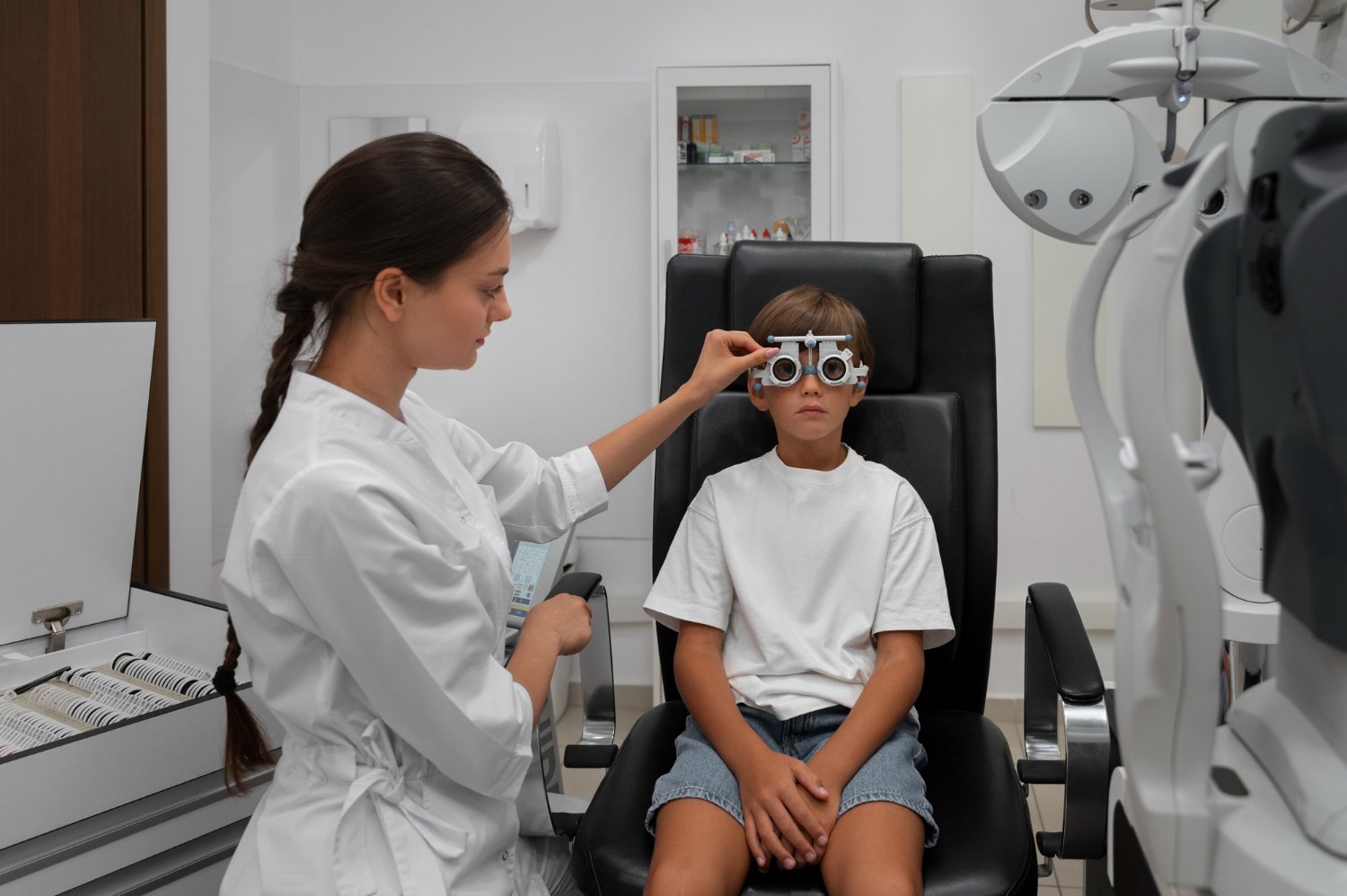
[…] Refractive errors like nearsightedness (myopia), farsightedness (hyperopia), and astigmatism […]